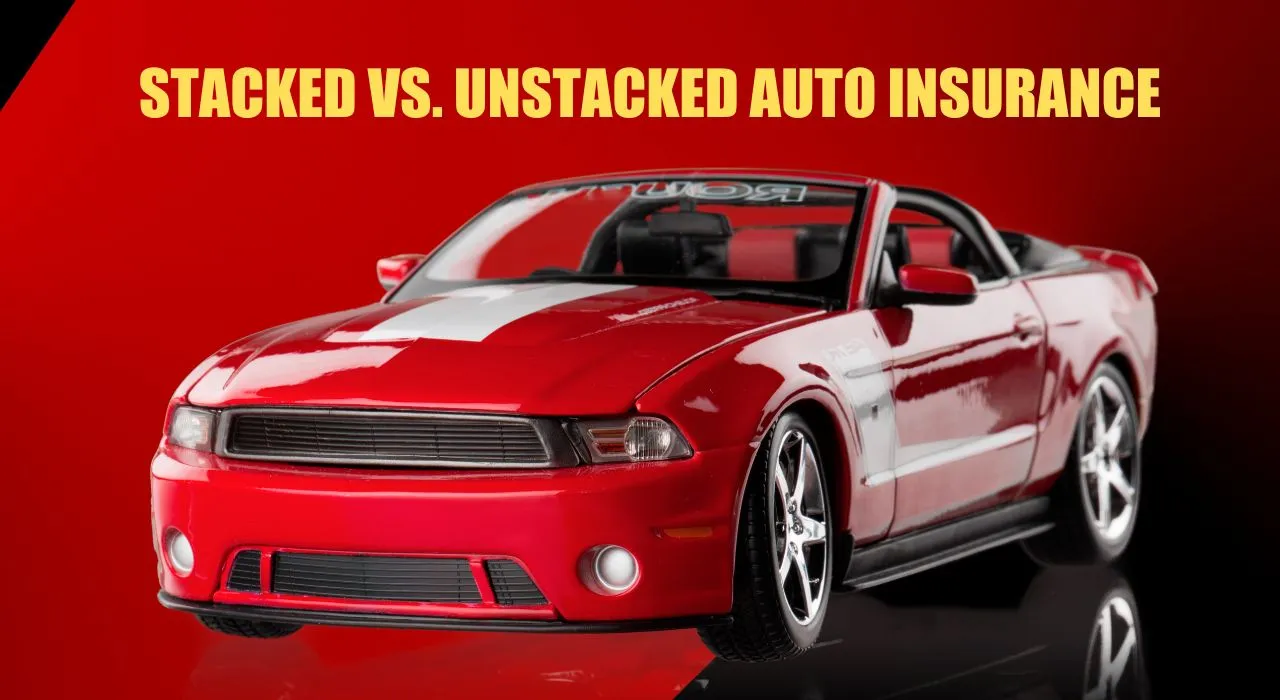If you own more than one vehicle or have multiple insurance policies, you may have the option to stack or unstack your uninsured and underinsured motorist coverage.
This can affect the amount of protection you have in case of an accident with a driver who has no or insufficient insurance.
In this article, we will explain what stacked and unstacked auto insurance are, how they differ in coverage and premiums, and what benefits and drawbacks they have. We will also provide some tips on how to choose between them based on your needs, budget, and risk factors.
Understanding Stacked and Unstacked Auto Insurance
Uninsured motorist (UM) coverage pays for your medical expenses and property damage if you are hit by a driver who has no insurance. Underinsured motorist (UIM) coverage pays for the difference between your damages and the other driver’s liability limits if they are not enough to cover your losses. Both UM and UIM coverage are optional in most states, but some states require them by law.
Definition of Stacked Auto Insurance
Stacked auto insurance allows you to combine or add up the UM and UIM coverage limits of multiple vehicles or policies. For example, if you have two cars with $25,000 of UM/UIM coverage each, you can stack them to get $50,000 of total coverage per accident. You can also stack coverage across different policies if you have more than one insurer.
Definition of Unstacked Auto Insurance
Unstacked auto insurance limits your UM and UIM coverage to the amount stated on each vehicle or policy. For example, if you have two cars with $25,000 of UM/UIM coverage each, you can only use $25,000 of coverage per accident per vehicle. You cannot combine or transfer coverage from one vehicle or policy to another.
Differences in Coverage and Premiums
The main difference between stacked and unstacked auto insurance is the amount of coverage you can access in case of an accident with an uninsured or underinsured driver. Stacked insurance gives you more coverage, while unstacked insurance gives you less.
Another difference is the cost of premiums. Stacked insurance is more expensive than unstacked insurance because it provides more protection. The exact difference in price depends on several factors, such as the number of vehicles or policies you have, the amount of coverage you choose, and the state where you live.
Benefits of Stacked Auto Insurance
Stacked auto insurance has several benefits that may make it worth the extra cost. Some of them are:
- Increased Coverage Limits: Stacking your UM and UIM coverage can significantly increase the amount of money you can receive in case of an accident with an uninsured or underinsured driver. This can help you cover your medical bills, lost wages, pain and suffering, and other damages that may exceed your regular liability limits.
- Protection Against Uninsured or Underinsured Drivers: According to a 2021 report by the Insurance Research Council, approximately one in eight drivers does not have car insurance. Additionally, many drivers have only the minimum liability coverage required by law, which may not be enough to pay for your damages if they cause an accident. Stacking your UM and UIM coverage can protect you from paying out of pocket for these situations.
- Flexibility to Combine Coverage Across Vehicles: Stacking your UM and UIM coverage allows you to use the combined limit for any vehicle involved in an accident with an uninsured or underinsured driver. For example, if you have two cars with $25,000 of UM/UIM coverage each, and one of them is totaled by an uninsured driver, you can use the $50,000 of stacked coverage to replace it. You do not have to use the $25,000 limit assigned to that specific vehicle.
Benefits of Unstacked Auto Insurance
Unstacked auto insurance also has some benefits that may make it a better option for some drivers. Some of them are:
- Potentially Lower Premiums: Unstacking your UM and UIM coverage can lower your insurance costs because it reduces the amount of protection you have. If you do not drive frequently or have a low risk of getting into an accident with an uninsured or underinsured driver, unstacking your coverage may save you money in the long run.
- Customization of Coverage for Individual Vehicles: Unstacking your UM and UIM coverage allows you to choose different amounts of protection for each vehicle or policy. For example, if you have a new car and an old car, you may want to have more UM/UIM coverage for the new car than for the old one. You can do that by unstacking your coverage and selecting different limits for each vehicle.
- Easier Policy Management for Single Vehicle Owners: If you only own or insure one vehicle, unstacking your UM and UIM coverage may simplify your policy management. You do not have to worry about stacking or transferring coverage from one vehicle or policy to another. You only have to deal with one limit and one premium.
Choosing Between Stacked and Unstacked Auto Insurance
Choosing between stacked and unstacked auto insurance depends on your personal preferences, needs, budget, and risk factors. Here are some tips to help you make an informed decision:
1. Assessing Your Coverage Needs
The first step is to determine how much UM and UIM coverage you need to protect yourself from the financial consequences of an accident with an uninsured or underinsured driver. You can use online calculators or consult with an insurance professional to estimate your potential damages and expenses. You should also consider your health insurance, disability insurance, and personal injury protection (PIP) coverage, if any, as they may cover some of your medical costs.
2. Considering Your Budget
The next step is to compare the cost of stacked and unstacked auto insurance and see how they fit your budget. You can get quotes from different insurers or use online comparison tools to find the best rates. You should also factor in the deductible, which is the amount you have to pay out of pocket before your UM or UIM coverage kicks in. A higher deductible can lower your premium, but it also increases your financial responsibility in case of a claim.
3. Evaluating the Risk of Uninsured or Underinsured Drivers
The final step is to evaluate the likelihood of getting into an accident with an uninsured or underinsured driver in your area. You can check the statistics on the percentage of uninsured drivers by state or by county to get an idea of the risk level. You should also consider other factors, such as the traffic density, the accident rate, and the legal requirements for liability coverage in your state.
4. Consulting with an Insurance Professional
If you are still unsure about whether to stack or unstack your UM and UIM coverage, you may want to consult with an insurance professional who can advise you based on your specific situation. They can help you understand the pros and cons of each option, answer your questions, and provide you with personalized quotes.
5. Additional Factors to Consider
Besides the above tips, there are some other factors that may influence your choice between stacked and unstacked auto insurance. Some of them are:
- State Laws: Not all states allow the stacking of UM and UIM coverage. Some states prohibit it outright, while others limit it to certain conditions or require specific disclosures or waivers. You should check the laws in your state before deciding to stack or unstack your coverage.
- Policy Terms: Some insurers may have different terms and conditions for stacked and unstacked auto insurance. For example, some insurers may require you to have the same UM and UIM limits for all vehicles or policies that you want to stack. Others may impose restrictions on how you can use your stacked coverage in case of a claim. You should read your policy carefully and understand the fine print before choosing an option.
- Future Changes: Your choice between stacked and unstacked auto insurance may change over time as your circumstances change. For example, if you buy a new car, sell an old car, switch insurers, move to a different state, or experience a significant change in income or expenses, you may want to review your UM and UIM coverage and see if stacking or unstacking still makes sense for you.
Conclusion
Stacked and unstacked auto insurance are two ways of managing your uninsured and underinsured motorist coverage. Stacked insurance allows you to combine or increase your coverage limits across multiple vehicles or policies, while unstacked insurance limits your coverage to each vehicle or policy separately. Stacked insurance provides more protection but costs more, while unstacked insurance provides less protection but costs less.
Choosing between stacked and unstacked auto insurance depends on several factors, such as your coverage needs, budget, risk level, state laws, policy terms, and future changes. You should weigh the benefits and drawbacks of each option carefully and consult with an insurance professional if needed.





